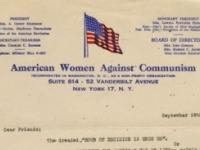For those of you who teach 20th Century US history, you might find the most recent lesson plan on the HSP website, “America and the Red Scare,” useful. This lesson includes primary sources from two opposing groups during the period.
The Red Scare (technically the second Red Scare, the first occurred during and after WWI) was a period following WWII when Americans were greatly concerned about the threat of Communism. The US was in the beginning of the Cold War with the USSR, and there was a fear that Communist spies would leak details about the atomic bomb, leading to a nuclear war. As Communism gained power in other countries, such as China, US citizens believed that communists might take over the US. In this climate of fear, Senator Joseph McCarthy began accusing many people of being Communist, blacklisting them and effectively ensuring that they were permanently out of a job.
In this lesson plan, students are able to read primary documents from the American Women Against Communism and the Pennsylvania Civil Rights Congress. Students will compare and contrast these two vastly different points of view. They will be encouraged to connect the period of the Red Scare to the present day and think about the tension that exists between civil liberties and public safety.
New lesson plans are being posted often, so check back soon if you do not find one you are looking for. In your summer curriculum planning, don’t forget to check out HSP’s resources for teachers!

